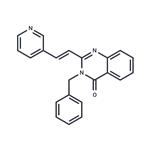Uses
3-(Phenylmethyl)-2-[(1E)-2-(3-pyridinyl)ethenyl]-4(3H)-quinazolinone is an inhibitor of human RAD51. RAD51 is involved in DNA repair and small molecules that inhibits RAD51 may be used to improve the efficacy of chemotherapy.
Uses
RAD51 Inhibitor B02 has been used:
- to test its effect on the polar body extrusion (PBE) rate in porcine oocytes
- for RAD51 inhibition in porcine embryos
- as RAD51 inhibitor and to test its effect on targeted nucleotide substitution (TNS) in induced pluripotent stem cells (iPSCs)
Definition
ChEBI: 3-(phenylmethyl)-2-[2-(3-pyridinyl)ethenyl]-4-quinazolinone is a member of quinazolines.
General Description
A cell-permeable pyridinylvinyl-quinazolinone compound that is shown to specifically inhibit human RAD51 (IC
50 = 27.4 μM). Does not affect RecA even at much higher concentration (~250 μM). Directly interacts with RAD51 (K
d = 5.6 μM), and disrupts its binding to DNA and nucleoprotein filament formation. Blocks double-strand break-induced homologous recombination and enhances sensitivity of cells to Cisplatin (
Cat. No. 232120) and Mitomycin C (
Cat. No. 47589), (Cat. No. 475820). Diminishes co-aggregate formation between RAD51-ssDNA filament and dsDNA. RAD51-Stimulatory Compound-1, RS-1 (
Cat. No. 553510) is also available.
Biochem/physiol Actions
B02 (3-(Phenylmethyl)-2-[(1E)-2-(3-pyridinyl)ethenyl]-4(3H)-quinazolinone), a pyridinylvinyl-quinazolinone compound is cell-permeable. B02 inhibits human RAD51 recombinase and subsequent nucleofilaments formation. It halts homologous recombination (HR) repair events in cancer cells. B02 favors apoptosis in multiple myeloma and is crucial for sensitizing them to doxorubicin.
![3-(Phenylmethyl)-2-[(1E)-2-(3-pyridinyl)ethenyl]-4(3H)-quinazolinone Structure](https://www.chemicalbook.com/CAS/20180703/GIF/1290541-46-6.gif)

